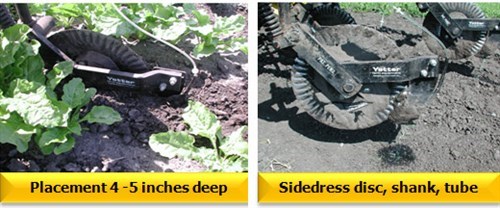566 - Maximizing Weed Control Sidedressing Nitrogen
The presence of resistant weeds in the American Crystal Sugar Company growing area makes it absolutely necessary to achieve complete weed control in 2012 and beyond. No weeds can be allowed to go to seed in any Roundup Ready® crop in the rotation. Weeds of greatest immediate concern are Waterhemp, Common and Giant Ragweed, and Kochia. If resistant Kochia, which has been documented in Central ND, spreads eastward into the RRV, weed control costs in sugarbeet will rise dramatically. It's imperative every possible effort be made to achieve total weed control in all crops in sugarbeet rotations to preserve glyphosate technology for your weed control program in beets
Strategies to Maintain the Effectiveness of Roundup Ready Sugarbeets:
- Fear the impact of glyphosate resistant weeds
- Eliminate weed seed production
- Be proactive to slow or stop resistant weed development
- Rotate crops and herbicide modes of action
- Eliminate weed seed production in rotational crops - it's easier in corn, soybean and wheat
- Diversify control strategies at all times, chemical, mechanical, labor
- React quickly to changing weed populations
- Be diligent in scouting for escapes
- Leave a legacy of successful weed control for future generations
Maximize Glyphosate Activity
- Begin when beets and weeds are in the cotyledon stage
- Use maximum allowable rates
- Best control is from 10 a.m. to 4 p.m.
- Add 8.5 to 17 lbs. of AMS per 100 gallons of spray solution
- Control is often better with lower volumes, about 10 gpa
- Rain within 6 hours may reduce weed control
- Avoid spraying with dust on plants
- Avoid spraying with dew on plants
- Cool weather slows activity and time needed for control
- Frost before application will reduce control
- Drought slows weed growth, reduces activity
- Air temperature over 85°F during application can reduce weed control
- Don't spray after sunset-weed control can be reduced
Tank Mixes With Glyphosate Critical to Success
- For resistant Common Ragweed use 3-4 oz. of Stinger in each application.
- Use Betamix and 4 oz. of Nortron when resistant Waterhemp is present
- Use split applications of Outlook or Dual in early layby applications for season long resistant weed control
- Start layby applications at the 2-4 leaf stage
BE RIGHT!
RIGHT RATE - RIGHT TIMING - RIGHT TANK MIX
Sidedressing Nitrogen
Yield and quality of your sugarbeet crop can be maximized or decreased depending on sidedressing timing and rate of nitrogen applied. Sidedressing too early without an accurate soil test could result in too little or too much applied nitrogen. Dr. Larry Smith, UM NWROC at Crookston conducted an excellent sidedressing study in 2011. Objectives were too evaluate rate and timing of nitrogen applications, Table 1.
Table 1: Yield and Sucrose Effects with 140 lb. N per Acre Applied at Different Times
| Applied Nitrogen | |||||||
|---|---|---|---|---|---|---|---|
| Residual | Post N | Total | Net | Gross | |||
| +Fall N | (lb./A) | Residual+ | RSA | RST | Yield | Sucrose | Returns** |
| (lb./A) | T1 T2 | Applied | (lb./A) | (lb./T) | (T/A) | (%) | ($/A) |
| 140 | - - | 140 | 10172 | 344 | 29.6 | 17.25 | 1832 |
| 110 | 30 - | 140 | 10099 | 342 | 29.6 | 17.10 | 1807 |
| 80 | 60 - | 140 | 10459 | 344 | 30.4 | 17.21 | 1884 |
| 110 | - 30 | 140 | 9305 | 335 | 27.8 | 16.74 | 1636 |
| 80 | - 60 | 140 | 9137 | 335 | 27.3 | 16.78 | 1604 |
T1 = 6-8 leaf stage
T2 = at canopy closure
Conclusions:
- Soil test just ahead of application
- Apply no later than 6-8 leaf stage
- Placement below soil surface for best results

Purdue Extension Service
Four Common Ragweed plants/30 ft. of row can reduce yield by up to 10% in soybeans.
FACT Sheet Available
More than 50 glyphosate formulations are available. Be sure the right rate and adjuvants are used. Ag staff have a fact sheet with all this product information described in detail.
